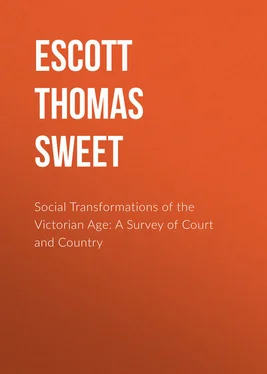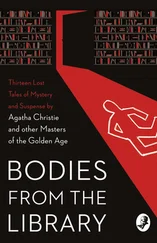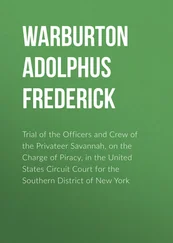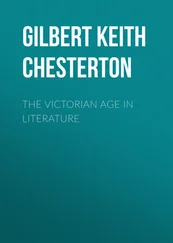The agencies that have changed the material basis underlying the structure of English society were thus fairly now in operation. They were supplemented by other circumstances all tending to produce the same result. Chief among these was the fact of the English coal supply surpassing that of other countries in its abundance and its universal distribution by land and sea. The character and the progress of the Victorian era are due in no small degree to the sagacity and shrewdness of the Prince Consort. He was now the first to recognize that the time had come when the cultivation of the artistic sense was alone needed to make the English workman the best in that world of which from the days of Chatham onwards, his country had been pre-eminently the workshop. French industry had not even yet recovered from the blow dealt to it by the revolution of the last century. That effacement of an earlier régime had differed in important particulars from all analogous movements in earlier ages. The havoc, the massacres, the proscriptions and confiscations of ancient Rome during her passage from a Republic to an Empire, had seriously affected the highest classes alone. The substitution for the French monarchy of a Robespierre first, of a Napoleon afterwards, had involved all orders in a common ruin. The Queen’s husband made it the business of his life to insure the maintenance of the advantage which history itself had thus given to English industry and manufacture, and which the fresh supply of the precious metal directly favoured.
The universal attraction to Englishmen of the Australian gold fields may be summarized in a very few facts and figures. In 1852 the English emigrants to the treasure stores of the Antipodes were 369,000; a larger number, that is, than was represented by the increase of the Queen’s subjects at home through the excess of births over deaths. Our population in fact stood still in order that Australia, like California, might be peopled. During the four or five years of the gold fever under the Southern Cross, we sent out 1,356,000; more, in other words, than the whole population of Scotland at the time of the Union. The annual average of English emigrants was thus a trifle over a quarter of a million. Somewhat later, the collapse of the railway mania in England and the potato famine in Ireland, swelled the average total of this annual exodus to nearly half a million.
Other results of the influx of gold during the second Victorian decade remain to be epitomized. The precious metal in the Bank of England, from less than eight millions in 1847, increased to twenty-two millions in 1853. The Bank rate during the whole decade was two per cent. The growth of trade was suddenly but steadily promoted. During 1853, twenty millions more of gold money than within any preceding twelvemonth changed hands among the public. Incidentally, it should be mentioned that a belief in the permanence of the low interest rate just mentioned caused Mr Gladstone, when Chancellor of the Exchequer in April 1853, to bring forward a scheme for the conversion of a portion of the three per cent. Consols, into Consols bearing a lower rate of interest, and that the interest on Exchequer Bills was a penny a day or one and a half per cent, per annum. The harvests of 1853-4 in England had been bad. The fresh purchases by the gold mine countries of English goods fully compensated us for the loss from this cause. The value of that custom may be judged from the figures which show the cost of life at the gold mines. In the early fifties flour rose to four times, meat to five times their usual value. An egg or a pill cost a dollar each. 5 5 While these lines are being prepared for the press there appears in a London newspaper a statement of the prices current at the Western Australia gold fields in the summer of 1896. They may be compared with the figures given in the text and are as follows: – Tea 3s., flour 10d., sugar 1s., bacon 3s., beef and mutton 4d. to 8d., cheese 2s. 6d., coffee 3s., tobacco 8s., and preserved potatoes 1s. 9d. per lb.; milk (condensed) 1s. 9d. per tin; flour 20s. per 50 lbs.; and eggs 10s. a dozen; but the cost of living generally, as compared with earnings, is low. On the Ashburton River gold fields mutton is 4d., beef 6d., flour 10d., tea 3s., sugar 9d. to 1s., preserved potatoes 1s. 6d., salt 1s., rice 1s., and oatmeal 1s. 3d. per lb. On the Yilgarn gold fields meat is 9d. to 1s. a lb., flour 10s. to 30s. per 50 lb. bag, tea 3s. 6d. a lb., and other provisions are equally scarce and dear. At Coolgardie, to the east of Yilgarn, flour costs £3 per 200 lbs., bread 1s. per 1½ lb. loaf, butter 2s. 3d. per lb., potatoes 6d. per lb., sugar 8d. per lb., tinned milk 1s. 3d. per lb., bacon 1s. 9d. per lb., salt 6d. per lb., and board and lodgings £3 to £7 a week. On the Murchison gold fields in the North, the prices per lb. are: Flour 8d., sugar 8d., tea 3s. 6d., tobacco 6d., fish 1s. 6d., mutton 8d., beef 8d., butter 3s., and tinned meats 1s. 3d.
For a miner in tolerable luck £2 were not an exceptional day’s earnings. Nor between the years 1849-55 and onwards were the effects of the gold discoveries on foreign and domestic trade less noticeable. Within a single period of twelve months, the value of our exports increased by one-fourth. Most of these were required by consumers in California or in Australia as the case might be. The rise of wages owing to the rush to the gold fields amounted in 1851-2 nowhere to less than twenty per cent.; in some trades it was twenty-five per cent. In London the price of bricks was increased by fifty per cent. Liverpool, Manchester, Birmingham shared the general prosperity. Agricultural labour was not paid at a rate proportionate to its scarcity. The extent of that scarcity may be judged from Sir Morton Peto’s suggestion that the Militia should be called in to complete the operations of harvesting which were interrupted by the inducements offered by contractors to navvies at wages varying between four shillings and threepence, and four shillings and sixpence a day. Thus the competition of the gold fields industry was directly instrumental, not only in increasing trade, and therefore production and wealth in the mother country, but in improving the condition of the industrial classes at home.
This rise in wages was not however a pure gain. Before the end of 1855 prices had increased by nearly one-half. The Preston strike of 1853-4 opened that campaign between industry and capital which has been paid for by the representatives of both with so serious a deduction from their profits. Before the Preston strike, the unions had been mainly political organizations; thereafter they became industrial. Meanwhile on the other side of separating oceans new Englands were being created with incredible rapidity by the new gold. Already indeed Her Majesty’s subjects, without leaving their native land knew something of the Eldorado which Australia constituted even before the treasures of Ballarat and Bendigo had been unearthed. While as yet the nugget was a prize of the future, fortunes were realized by the shearing of flocks. Long before the 1851 Exhibition the Australian millionaire, returned to his native land, had become familiar to Victorian London. He did not yet often live in Grosvenor Square. He was to be found frequently in the best houses of the scarcely less palatial Westbourne Terrace or at a later date in Rutland Gate. The gold which enriched England created Australia, whose capitals can scarcely be said to have existed before the thirteenth or fourteenth year of the present reign. Gold gave to Victoria civilization and government. It built Melbourne. The same omnipotent agency changed New South Wales from a sparsely-inhabited tract to a populous and prosperous State. The extreme youth, as national life is computed, of Australia will perhaps best be realized when it is remembered that the founder of Melbourne, John Pascoe Falkner was yet alive, and welcomed to his capital the Duke of Edinburgh on the occasion of his visit to the Antipodes in 1860; and that Henty, Falkner’s associate and senior, survived at least to 1882.
Читать дальше












